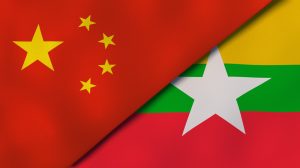Nearly 15 months after the military coup in Myanmar, the junta’s relationship with China is warming up, with a recent resumption in diplomatic exchanges, though both sides are keeping a low profile. The China Myanmar Economic Coordinator (CMEC), the umbrella for a host of infrastructure projects designed to link China’s Yunnan province to Myanmar’s western coast, continues to be a top priority for both sides, along with border security.
Given the uncertain political and security dynamics in Myanmar since the February 2021 coup, and the associated high risks for project financing, the development of new infrastructure projects is not a viable option for the foreseeable future, even if the overall implementation of CMEC is expected to proceed. Nonetheless, Naypyidaw and Beijing are venturing beyond the conventional paradigm of infrastructure-oriented engagement. In particularly, there are the three strategic areas of cooperation that will influence the reorienting of the CMEC and China-Myanmar relations in the months to come.
First, although it is still in its early stages, the Chinese digital renminbi has already stolen a lead in the Central Bank Digital Currency (CBDC) game. This is a technology that could be of great use for Myanmar. Along with the recent agreement establishing renminbi as the official settlement currency for trade with China, the Chinese digital currency could help Myanmar in its attempts to reduce its reliance on the U.S. dollar in trade and mitigate against potential restrictions of its access to the SWIFT international payment messaging system.
In addition, a direct settlement between the Digital RMB and the upcoming CBDC Myanmar kyat is a strategic projection for Naypyidaw, as well as being advantageous for Beijing in terms of trade efficiency and potential financing for upcoming projects. Of course, the digital Myanmar kyat still requires infrastructure to be rolled out at the retail level, which could take some time.
Second, Myanmar’s retail sector is now a strategic front of the Chinese private sector. The Chinese Alibaba-owned eCommerce platform shop.com.mm has already captured the lion’s share of the market in Myanmar, particularly by allowing digital payments during the 2021 cash crisis. Although eCommerce is still in its early stages in Myanmar, it will reach its full potential with the establishment of direct renminbi-kyat exchange and an expanded logistics network. Indeed, the race to claim the virgin retail market by developing a dominant “super app” is still in its early stages, but progress will require Chinese technology and experience regardless of who develops it. No doubt, in this political landscape, this is a race reserved for Chinese tech firms, as the political cost for western retail firms is too high to compete in Myanmar.
Third, alongside its successful vaccine diplomacy, Beijing has transferred to Myanmar the technology to produce a Chinese COVID-19 vaccine under the brand name Myancopharm. Without many competitors, Beijing’s COVID-19 diplomacy in Myanmar has been a relative success. And it opens the way for newly established Chinese pharmaceutical companies to invest in Myanmar’s generic drugs market, which is still dominated by imports from India. Although it may take some time to gain market share, entrepreneurs in Myanmar are already looking for an alternative source of generic drugs and production due to the country’s high market demand and the steep U.S. dollar-kyat exchange rate, which has made imports more expensive. Of course, with Beijing’s political support, fierce competition in the local market is only a matter of time.
The implementation of infrastructure projects under CMEC is still on the bilateral agenda, but the new political dynamic in the country and the changing strategic needs of both Naypyidaw and Beijing are altering the trajectory of the relationship. Nevertheless, it is time to look beyond CMEC and the Belt and Road Initiative as solely infrastructure-oriented and consider the frontier sectors in which China is competing globally.
































